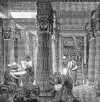Ancient Alexandria and the dawn of medical science
- PMID: 24749113
- PMCID: PMC3991212
- DOI: 10.5339/gcsp.2013.47
Ancient Alexandria and the dawn of medical science
Figures






References
Bibliography
Lexical Works:
-
- Brill's New Pauly: Encyclopaedia of the Ancient World. Edited by Hubert Cancik and Helmuth Schneider. Leiden: Brill, 2002.
-
- The Cambridge Ancient History. 3rd ed. Cambridge: Cambridge University Press, 1970.
-
- Der Kleine Pauly: Lexikon der Antike. Edited by Konrat Ziegler and Walther Sontheimer. 5 vols. München: Deutscher Taschenbuch, 1979.
-
- The Oxford Classical Dictionary. Edited by Simon Hornblower and Antony Spawforth. 4th ed. Oxford: Oxford University Press, 2007.
-
- Real-Encyclopädie der classischen altertumswissenschaft. Edited by A. Pauly, G. Wissowa, and W. Kroll. Stuttgart: Verlag J.B. Metzler, 1962.
General Works:
-
- Clagett, Marshall. Greek Science in Antiquity. Mineola, NY: Dover, 2001.
-
- Cumston, C.G. The History of Medicine: From the Time of the Pharaohs to the End of the XVIIIth Century. London: Routledge, 1998.
-
- Fraser, P.M. Ptolemaic Alexandria. 3 vols. Oxford: Clarendon Press, 2001.
-
- Gill, Christopher, Tim Whitmarsh, and John Wilkins, eds. Galen and the World of Knowledge. Cambridge: Cambridge University Press, 2009.
-
- Glanville, S.R.K., ed. The Legacy of Egypt. Oxford: Clarendon Press, 1957.
Publication types
LinkOut - more resources
Full Text Sources
Other Literature Sources
